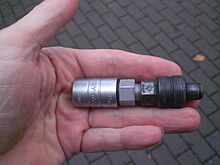Puller
The puller is a tool for loosening strained connections from components in mechanical engineering .
It is required to loosen pressed, shrunk or drawn in components that are held in their position by their own frictional force . The pulling force is generated by a screw or a hydraulic press .
- The best known are two- or three-legged universal pullers for loosening pressed-on parts from axes or from bores, such as. B. bushings, ball bearings and. Ä. The width and depth of attack can be varied with these pullers.
- For loosening parts that are drawn into a tapered bore, such as B. Ball joint pins in steering axles of automobiles , pullers in the form of short massive inverted pliers are used. One side is pushed apart with a screw, the other pushes the bolt out of the tapered bore.
- Component-specific extractors mostly have a special receiving element (mostly a thread ) and a concentric release or extraction screw. But they can also have very special shapes.
- Many bicycles have a conical square on the pedal axis. To loosen a crank , a crank puller is screwed into it. In some cranks, the pull-off function is already integrated through a screwed-in socket : The crank fastening screw (hexagon socket) is loosened, then screwed up further. In doing so, it presses from the inside on the bushing that presses the crank off the axle.
Web links
Commons : Puller - collection of images, videos and audio files
Wiktionary: puller - explanations of meanings, word origins, synonyms, translations


